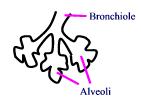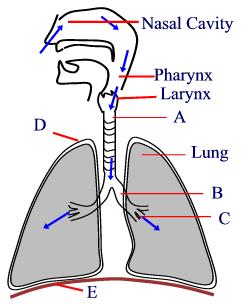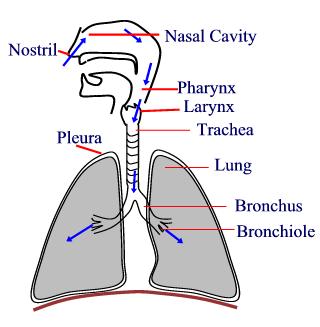|
Hide all answers
Hide all answers
View all answers
View all answers
Print
Try the Quiz
Given the QUESTION, identify the ANSWER
1. Exchange of air occurs in _______ which are also known as 'air sacs'.
• Alveolar ducts
• Bronchi
• Alveoli
• Bronchioles
Answer: AlveoliGaseous exchange occurs in alveoli. Due to the presence of alveoli, surface area of the lungs for exchange of gases increases to a great extent. 
2. Identify bronchus in this diagram.

• A
• B
• C
• D
Answer: B
3. Write the correct sequence of the pathway through which air travels after entering the body.
A. Larynx, pharynx, trachea bronchioles
B. Pharynx, larynx, trachea, bronchioles
C. Pharynx, larynx, bronchioles, trachea
D. Pharynx, trachea, larynx, bronchioles
• A
• B
• C
• D
Answer: BThe blue arrows in the following diagram denote the passage of air in the respiratory tract after entering through the nostrils. 
4. Which process does not occur in the nasal cavity?
A. Trapping of large foreign bodies
B. Exchange of gases
C. Humidification of inhaled air
D. Warming of inhaled air
• A
• B
• C
• D
Answer: BGaseous exchange occurs in lungs.
5. Normal rate of respiration in an adult human being is _______ times/ minute.
A. 10-12
B. 12-14
C. 16-18
D. 22-24
• A
• B
• C
• D
Answer: C
6. Spirometer measures:
A. Capacity of lungs
B. Volume of air inhaled and exhaled
C. Residual air
D. All of these
• A
• B
• C
• D
Answer: DSpirometer is an instrument used to measure various lung volumes and lung functions.
7. Identify diaphragm in this diagram.

• B
• C
• D
• E
Answer: EDiaphragm is a respiratory muscle which lies underneath the lung bases.
8. Complete the equation:
Glucose + Oxygen = _______ + Water + CO2
• Energy
• Sucrose
• Starch
• None of these
Answer: EnergyIn the tissues, glucose reacts with oxygen to produce energy which is used in various cell activities. Water and CO2 are formed as by-products.
9. What is the leaf-like structure which prevents the entry of food into respiratory passages?
• Larynx
• Epiglottis
• Pharynx
• Tongue
Answer: Epiglottis
10. Which part of the respiratory tract is also known as the voice box?
• Larynx
• Pharynx
• Trachea
• Epiglottis
Answer: LarynxVoice is produced in the larynx; therefore it is also known as the voice box.
11. Which cells of the blood carry oxygen to different parts of the body?
Answer: Red blood cellsHemoglobin present in the red blood corpuscles (RBCs) carries oxygen to different parts of the body.
12. True or False: Trachea contains 16-20 'C'-shaped cartilaginous rings.
• True
• False
Answer: TrueCartilagenous rings prevent the trachea from collapsing.
13. True or False: Breathing through the mouth is considered as good as breathing through the nose.
• True
• False
Answer: FalseHairs and mucus present in the nasal cavity trap the foreign particles and bacteria and thus prevent them from entering the body. This function cannot be achieved when we breathe through the mouth.
14. True or False: Exhalation and inhalation of air is known as "cellular respiration".
• True
• False
Answer: FalseVarious metabolic activities of the body need oxygen for energy and produce CO2 as an end product. This exchange of gases at the cellular level is known as cellular respiration.
15. True or False: Two-layered membrane which covers the lungs is known as pericardium.
• True
• False
Answer: FalseIt is 'pleura'. Pericardium covers the heart.
Try the Quiz : Biology : Human Respiratory system
|